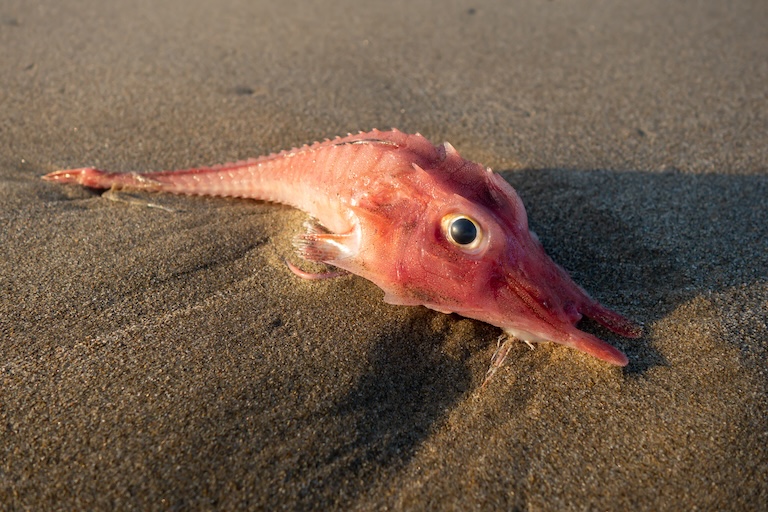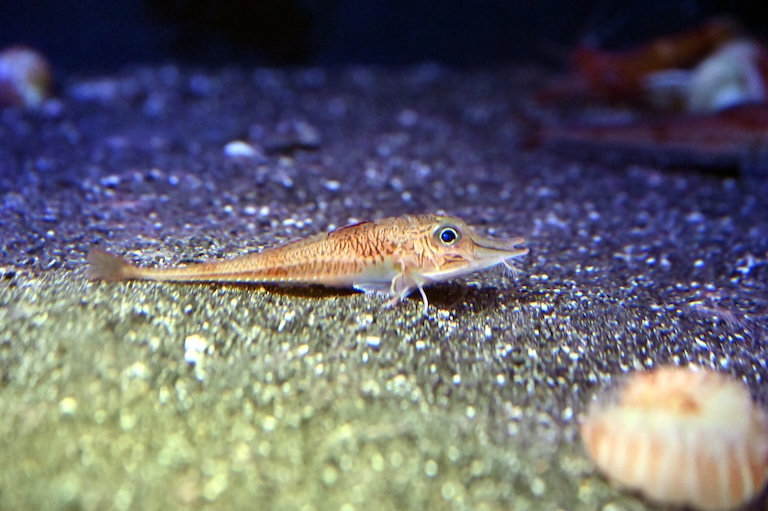Armoured Sea Robin Profile
Picture the scene: you’re new to the tabletop roleplaying game world. Everyone’s designing their mythical characters, wolves with lasers in their eyes, giant sand worms made of obsidian, prehistoric and timeless druids who can walk on tea; then it comes to your turn.
Feeling very proud of yourself, you put forth a walking marine character: elongated, spiny, with a kite-shaped armoured head and a combine harvester attachment for a mouth.
Oh, and it’s red! And it has a skeleton for a tail, a pair of extendable blue wings, and thick protective plating all over it.
It’s called the “Armoured Sea Robin”.
Your appeals fall on deaf ears as they slam the door in front of you, and the echoes of their laughter haunt you all the way home. Back to animal blogging, then.

Armoured Sea Robin Facts Overview
| Habitat: | Warm marine waters, continental slopes below 180 m (590 ft) |
| Location: | Atlantic, Indian and Pacific Oceans |
| Lifespan: | Unknown |
| Size: | From 7 cm (2.8 in) in the smallest species to 48 cm (19 in) in the largest |
| Weight: | No more than 1 kg (2.2 lb). |
| Colour: | Very varied between species; including reddish-brown, grey, tan, or olive-green |
| Diet: | Small invertebrates, crustaceans, and worms |
| Predators: | Larger fish, sharks, and possibly mammals |
| Top Speed: | Slow |
| No. of Species: | Around 45 |
| Conservation Status: | Not listed |
Armoured sea robins are more than just a fantasy class of amphibious bomber support to regular sea robins, they’re also a family of really weird fish found in warm and temperate continental shelf waters, where they spend their days pottering about the sea bed on legs they can taste with and talking to one another by clicking their bladders.
This prehistoric looking fish is actually quite a special example of new adaptations that arise when there are certain constraints to overcome.
Interesting Armoured Sea Robin Facts
1. They’re related to sea robins
There are over 145 listed species of sea robins, but not all sea robins are as well defended. The majority fall into the gurnard family of Triglidae and are just plain sea robins.
These are a different family, but one that’s closely related to the armoured sea robins, who comprise around 45 species in six genera within the family Peristediidae.
Both families are in the lionfish order of so-called mail-cheeked fishes, due to the presence of hard plates on their faces in many species. Both sea robins and armoured sea robins have these, but the armoured sea robins take it one step further. 1 2

2. They’re armoured
While sea robins have hardened plates over their heads, the armoured sea robins are covered in them. Each plate on its body has a corresponding spine, too, and these plates are arranged in overlapping rows, making it a tough fish to eat.
But they also provide support for the body, sacrificing flexibility for rigidity, as this is a species that prefers waking over swimming.
3. They walk the walk
These fish are benthic specialists, and spend most of their time hunting for food on the sea bed and so underneath all this armour is something even more peculiar. A combination of sensory barbels and modified rays from their pectoral fins help them move along the benthic environment as if walking.
Their creepy protrusions look a lot like Mr Burns’ fingers and form six leg-like appendages that form as the fish ages, from a normal swimming fin in the juvenile into an eerie rake for pulling it along the sediment.
These “legs” can also sift through the sediment looking for food, and some hypothesise they may even be able to taste with them.
While the appendages don’t appear to have tastebuds as such, there are signs that they have some form of chemoreception properties. Given that some species potter about at depths of up to 500 metres, this is a very handy organ to make use of in the dark. 3 4
4. They talk the talk
The very and disappointingly dead Mitch Hedberg once observed, “If fish could scream, the ocean would be loud as shit”. But this was before we knew fish could vocalise at all.
It’s becoming apparent that far from the silently stoic, expressionless animals we always assumed fish to be, they have a hidden world of communication we are barely beginning to recognise.
Several branches of bony fish have now been confirmed to chatter away, but without access to vocal cords, this sound is produced using their swim bladder. Seemingly in a similar process to cetacean melons, these bladders can be manipulated to amplify and direct various clicks, croaks and growls.
The sea robins are one group thought to do this, and it appears the sounds serve much of the same purpose as ours do: mating or territorial disputes. Again, this is another useful adaptation to low-light environments where it might be hard to spot an erection or a flag.
Alongside their armour, this ability to make noise may also startle predators. 5
5. They make terrible robins
These fish don’t do an awful lot of flying but they do have some impressive wings. Their wide pectoral fins can fan out and present elaborate patterns and bright colours, presumably more useful in the shallower water environments.
The wide fanning nature of the fins helps them make the most of a glide when they do choose to swim and can carry them long distances as a way to compensate for other parts of their swimming hardware turning into legs.
Overall, this is a highly specialised animal suited to the benthic marine environment and this makes it a curiosity for evolutionary biologists.
6. They are great for people who study evolution
The nervous system that’s evolved in such a strange animal is fascinating. The sensory role their ‘legs’ apparently play in predation has led to some unusual adaptations in regard to how information is collected, transmitted and processed.
Their spines show massively enlarged ganglia for this purpose, sending thick, branched nerves down into the spines. These ganglia are arranged in spinal lobes, one for each leg, and these structures are not present in legless fishes.
All of this presents a brilliant example for studying novel traits and how they arise in specialist animals.
It’s thought that rather than being a primitive feature, the walking legs arose as an adaptation to the sacrifice in movement and speed that the armour plating created. Essentially, the fish slowed down and became benthic as it evolved better protection from predators.
Armoured Sea Robin Fact-File Summary
Scientific Classification
| Kingdom: | Animalia |
| Phylum: | Chordata |
| Class: | Actinopterygii |
| Order: | Platycephaloidei |
| Family: | Peristediidae |
Fact Sources & References
- “THE SEA ROBINS OR GURNARDS AND THE ARMORED SEA ROBINS”, Cybrary.
- Toshio Kawai (2008), “Phylogenetic Systematics of the Family Peristediidae (Teleostei: Actinopterygii)”, JStage.
- Nicola Davis (2024), “Crazy little fish have a lot to tell us’: sea robins use ‘legs’ to taste way to prey”, The Guardian.
- Ashley Strickland (2024), “Sea robins are fish with ‘the wings of a bird and multiple legs like a crab”, CNN Science.
- Dan Radel (2015), “Ocean Facts: a fish that drums and croaks”, app.
